

High School - IL Stats. Pythagorean Theorem. There are many, many proofs of the Pythagorean Theorem.
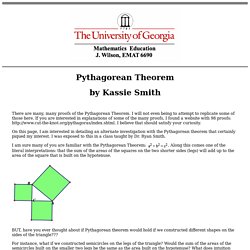
I will not even being to attempt to replicate some of those here. If you are interested in explanations of some of the many proofs, I found a website with 98 proofs: I believe that should satisfy your curiosity. On this page, I am interested in detailing an alternate investigation with the Pythagorean theorem that certainly piqued my interest. I was exposed to this in a class taught by Dr. Ryan Smith. But does it makes sense that it does? Conceptua Math – Online Math Curriculum. Why Teach Mathematics? By Mathew Felton, Posted June 23, 2014 – NCTM’s new Principles to Actions: Ensuring Mathematical Success for All aims to ensure high-quality mathematics education for all students.
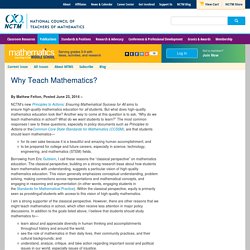
But what does high-quality mathematics education look like? Another way to come at this question is to ask, “Why do we teach mathematics in school? What do we want students to learn?” The most common responses I see to these questions, especially in policy documents such as Principles to Actions or theCommon Core State Standards for Mathematics (CCSSM), are that students should learn mathematics— for its own sake because it is a beautiful and amazing human accomplishment; andto be prepared for college and future careers, especially in science, technology, engineering, and mathematics (STEM) fields.
Borrowing from Eric Gutstein, I call these reasons the “classical perspective” on mathematics education. I am a strong supporter of the classical perspective. What do you think? Archived Comments. NRC’s Five Strands of Mathematical Proficiency. As part of my rising AP Calculus students’ summer work, they are to review six slides I created to illustrate the five strands of mathematical proficiency defined by the National Research Council (NRC).
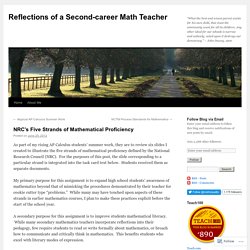
For the purposes of this post, the slide corresponding to a particular strand is integrated into the task card text below. Students received them as separate documents. NRC’s Five Strands of Mathematical Proficiency. As part of my rising AP Calculus students’ summer work, they are to review six slides I created to illustrate the five strands of mathematical proficiency defined by the National Research Council (NRC).
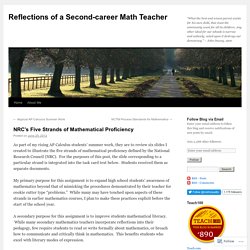
For the purposes of this post, the slide corresponding to a particular strand is integrated into the task card text below. Students received them as separate documents. My primary purpose for this assignment is to expand high school students’ awareness of mathematics beyond that of mimicking the procedures demonstrated by their teacher for cookie cutter type “problems.” While many may have touched upon aspects of these strands in earlier mathematics courses, I plan to make these practices explicit before the start of the school year. A secondary purpose for this assignment is to improve students mathematical literacy. A tertiary purpose is to offer students a diverse set of work from which I may learn more about them as students of mathematics. Questions for my readers: Dr. Jennifer M. Suh. Click on each strand for classroom structures that promote this strand: (1) Conceptual understanding (aka.

Understanding) refers to the “integrated and functional grasp of mathematical ideas”, which “enables them [students] to learn new ideas by connecting those ideas to what they already know.” A few of the benefits of building conceptual understanding are that it supports retention, and prevents common errors. (2) Procedural fluency (aka.
Computing) is defined as the skill in carrying out procedures flexibly, accurately, efficiently, and appropriately. (3) Strategic competence (aka. . (4) Adaptive reasoning (aka. . (5) Productive disposition (aka. Jennifer Suh, Assistant Professor, Graduate School of Education, College of Education and Human Development teaches an EDCI 552 course, Mathematics Methods for the Elementary Classroom, at George Mason University’s Fairfax Campus. The Five Strands of Mathematics. (1) Conceptual understanding refers to the “integrated and functional grasp of mathematical ideas”, which “enables them [students] to learn new ideas by connecting those ideas to what they already know.”
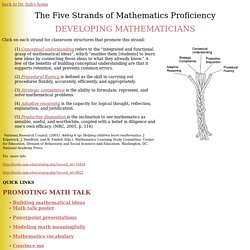
A few of the benefits of building conceptual understanding are that it supports retention, and prevents common errors. (2) Procedural fluency is defined as the skill in carrying out procedures flexibly, accurately, efficiently, and appropriately. (3) Strategic competence is the ability to formulate, represent, and solve mathematical problems. (4) Adaptive reasoning is the capacity for logical thought, reflection, explanation, and justification. (5) Productive disposition is the inclination to see mathematics as sensible, useful, and worthwhile, coupled with a belief in diligence and one’s own efficacy. National Research Council. (2001).